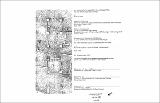An approach to a regional architecture at the mouth of the Ganges
Author(s)
Javed, Shamim
DownloadFull printable version (21.78Mb)
Alternative title
Mouth of the Ganges, An approach to a regional architecture at the
Other Contributors
Massachusetts Institute of Technology. Department of Architecture.
Advisor
William L. Porter.
Terms of use
Metadata
Show full item recordAbstract
The retreat of Colonial rulers and the emergence of a new self identity among many of the once colonized nations of Asia, Africa and Latin America is one of the significant features of the current century. In the field of architecture, the expression of this independent spirit was delayed by the tenets of the Modem Movement that was sweeping the globe at about the same time. Now that this movement has run its course, leaving very little that is positive in the developing countries, architects from these nations are turning to their own history and culture to find guidelines for their work. As an architect from Bangladesh, that land where the mighty Ganges meets the sea, I feel a desire to do the same. The search for a basis of architecture in the spirit of Bangladesh can quickly become a progressively diverging inquiry encompassing questions like what is the purpose of architecture, what is the spirit of Bangladesh and why an architecture in the spirit of Bangladesh? Such an open-ended investigation, much beyond the scope of this thesis, has been given a manageable boundary by focussing on a museum design at the bank of the river Burhiganga in Dhaka, Bangladesh. A specific site offers the advantage of a much more tangible past and present to relate to and project a future from. The challenge was to connect these three timeframes without being simplistic. The zamindar-bari of Rupial, currently lying abandoned on the site, evokes the memory of a past typified by aristocratic rule. The life of the common people that permeates the site and its surroundings today is taken as a symbol of democratic spirit that one hopes would reign the present and the future. The Museum building sets up a dialogue between aristocracy and democracy where the later supersede the former. The process does not destroy the old but, rather, transforms it to serve the new; the past belongs to the present as the present to the future.
Description
Thesis (M.S.)--Massachusetts Institute of Technology, Dept. of Architecture, 1987. MICROFICHE COPY AVAILABLE IN ARCHIVES AND ROTCH. Includes bibliographical references (leaves 36-38).
Date issued
1987Department
Massachusetts Institute of Technology. Department of ArchitecturePublisher
Massachusetts Institute of Technology
Keywords
Architecture.